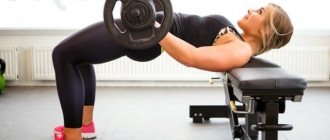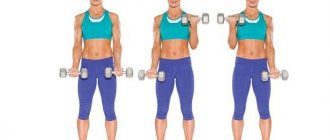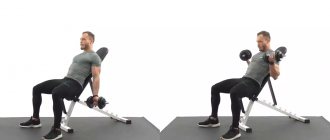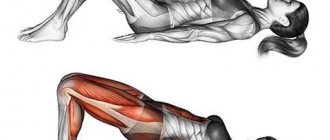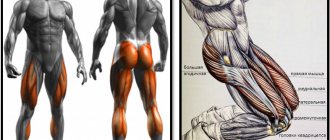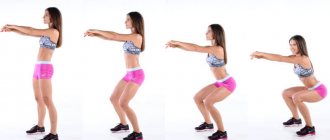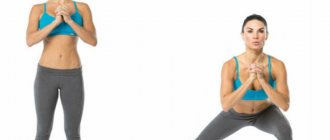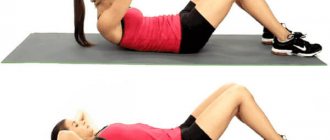The peculiarity of such an exercise as hyperextension is its universal nature. Initially, the movement was invented to strengthen the long back muscles, biceps of the thighs and buttocks on a “residual” basis. But you can’t fool bodybuilders - they will adapt any exercise to their needs. “Gluteal” hyperextension was born, by the way, not in the depths of an aesthetic sport, but in weightlifting. There it bore the prosaic name “lifting the body through a sawhorse with a rounded back” and served as an auxiliary exercise in the snatch and clean and jerk. Someone noticed that it is in this position that the buttocks experience the maximum load; the exercise was adopted by figure correction trainers. And so, a completely ordinary movement is now called either “gluteal hyperextension” or “extension for girls.” Be that as it may, the exercise has a lot of nuances that you need to know in order to cope with the load without consequences for the body.
Content
- Step-by-step description of the classic technique
- How to properly perform hyperextension for the back?
- How to properly exercise on a hyperextension machine:
- Features of performing hyperextension on the buttocks and back
- Common mistakes in hyperextension technique
- Options for performing hyperextension Reverse hyperextension
- Hyperextension with weights
- Lateral hyperextension
The main load falls on the back extensor muscles - the long muscles along the spine, the gluteus maximus and the hamstrings. The exercise is suitable if you train at home, as it can be performed without special equipment.
What muscles are involved?
Hyperextension is an isolation exercise. Those that are aimed at working out one specific muscle group or muscle (most often lagging behind in pumping). In our case it is the back.
Note! There are no completely isolation exercises. When performing hyperextension, for example, we additionally use the gluteal, calf and thigh muscles (biceps, semitendinosus and semimembranosus).
As a result of such training, you will be able to quickly strengthen your lower back without loading the intervertebral discs. The whole body will be in good shape.
Step-by-step description of the classic technique
How to properly perform hyperextension for the back?
The classic version of the exercise is performed on a special hyperextension machine. It is a machine with platforms for fixing the body and feet. In this case, not only the back muscles are pumped, but also the back of the thigh (femoral biceps) and buttocks.
How to properly exercise on a hyperextension machine:
- Adjust the machine so that your pelvis rests firmly on the pillow. The edge of the pillow should be where the body bends. Everything above the waist is not supported.
- Place the back of your legs—the Achilles tendon, not the calves—on the bolsters.
- Cross your arms behind your head or on your chest. Straighten your body in a completely straight line. Look straight ahead. The center of gravity is on the heels.
- Lower your body down, bending only at the waist.
- Once you reach the 90° angle, return the body back to the starting position. When moving, avoid jerking and hyperextension of your back.
- Hold at the top for 1-2 seconds. Perform the required number of repetitions. On average, it is recommended to do 3 sets of 15-20 repetitions.
Hyperextension for the lower back using the classical technique can be done on a pommel horse. In this case, the socks are placed behind the crossbar of the wall bars or secured by a partner.
Starting position: lying face down on a horse. The pelvis is on the support of the projectile. Legs – at head level or lower. The arms are fixed crosswise on the chest or behind the head. The technique is the same as on a special simulator.
Features of performing hyperextension on the buttocks and back:
- The higher the support, the more the spinal extensors are loaded. The lower it is, the more the hamstrings are worked.
- The lower back should not be round - it should be arched so that the pelvis goes back.
- If you want to pump up the spinal extensor muscles, lower your body as far as possible. This version of the exercise puts extreme stress on the spine, so it is not recommended as a working exercise.
- If the pillow rests on the middle of the thigh, and part of the pelvis is outside the support, then the main load passes from the back to the back of the legs and buttocks.
- Lower as you inhale, rise as you exhale.
- First, hone the correct technique for performing the exercise and only then do it with weights.
Common mistakes in the hyperextension technique:
- Large range of motion - beginning athletes often lift their body excessively at the top point and bend their body by 15-25°. This option for performing the exercise is acceptable if you are doing the last repetition and want to stretch or pull the muscles after an abdominal exercise. This technique is not suitable as a working technique, as it can harm the spine.
- Fast jerky movements. Make all movements slowly and smoothly.
- Keep the weight behind the back of your head, not behind your head - this will overload your spine. If the weight is further than the top of the head, the arms are additionally loaded, as with a basic exercise for all muscle groups.
Options for performing hyperextension
In addition to classical hyperextension, there are other options for performing the exercise - reverse, lateral, with weights, etc. This helps to shift the load vector.
Reverse hyperextension
Reverse hyperextension helps thoroughly work the gluteal muscles, as well as the iliocostalis and lower long back muscles. The auxiliary muscles involved are the biceps femoris, semitendinosus, rectus and oblique abdominal muscles, and arms.
The exercise is safer for the spine compared to the classic version. It represents the extension of the hips with a fixed position of the body. In the positive phase of the movement, an isolated load is provided, and in the negative phase, high-quality stretching is provided. It is performed on a specialized machine in which the body is parallel to the floor, and the legs are raised up and placed behind special rollers. You can use a Roman chair or sports bench instead.
- Starting position – body on a support, legs in the air. Body support is on the lower abdomen. Hands hold on to the footrest. The buttocks are tense throughout the entire exercise. Keep your head straight, do not throw it back.
- Bend at the waist and lift your legs as high as possible.
- At the bottom point, relax your buttocks.
- Do 3 sets of 10-15 repetitions.
When performing the exercise, do not strain your neck and core muscles. This will not only make the training ineffective, but can also cause sprains and injuries. To put more stress on your thigh muscles, turn your toes inward.
After mastering the basic technique, you can use leg weights. You can also hold a dumbbell or exercise ball between your legs. Before performing reverse hyperextension with weights, a warm-up is necessary, such as unweighted squats or race walking with high knees.
Reverse hyperextension with weights does not strain the back, so it can be performed before barbell squats or deadlifts.
Hyperextension with weights
Increases the load on the lower part of the spinal extensors. The main rule of performing the exercise is to prepare the muscles for the load. Therefore, the first approach is usually done without weight. Then it is gradually increased in increments of ±5 kg (individually). Another option is to perform it as a final exercise after training on complex machines in order to “finish off” the back muscles.
Technique:
- The starting position is the same as for classical hyperextension. Press the pancake to your chest with your hands crosswise.
- As you inhale, move your body down until you feel tension in your hips without rounding your back.
- As you exhale, return to the starting position.
There is an option to perform the exercise with a bar on the neck - this way the load is shifted to the middle part of the spinal extensors. The position of the bar is the same as for squats with a barbell. It is important to look forward and not bend your neck to avoid injury.
To pump up the buttocks, at the lowest point the torso should be parallel to the floor. Do not swing to avoid injury. Repeat as many times as necessary. Without a special simulator, the exercise can be performed with a partner. An analogue of hyperextension with weights is traction on stiff legs.
Lateral hyperextension
An effective exercise for working the abdominal parts of the oblique muscles. Partially engages the quadratus lumborum muscles and spinal extensors. It is performed in a special simulator or on a Roman chair.
Technique:
- Set the incline angle on the simulator to 20-40°.
- Place your feet on the platform - together or one in front of the other. The shin rests against the side surface of the roller at the bottom of the machine.
- The outer thigh rests on the top roller of the machine. Its edge is at the level of the upper part of the pelvis or slightly lower.
- Hands folded on the chest or behind the head.
- As you inhale, lower your body as far as flexibility allows for maximum stretching of the side muscles.
- As you exhale, return to the starting position - until you are in a straight line with your legs.
Experts recommend performing auxiliary hyperextension techniques only after you have mastered the classic one.
Common mistakes
Often in the gym you can find a muscleman who performs a kind of hyperextension on a machine: his back is rounded, his head is lowered, his knees are resting, and in his hands he flaunts a huge 30 kg pancake. Of course, the wrong technique will completely kill his vertebrae, and a massive weight will speed up this process significantly. Let's look at the most common mistakes when performing the exercise:
- Too much range of motion. Your vertebrae are not in danger only if your amplitude does not exceed 45 degrees.
- Incorrect torso position. Your torso should be hanging completely off the bench or elevated surface. Otherwise, it is impossible to perform the exercise correctly.
- Incorrect weight. The point of this exercise is to safely work your back muscles without overloading. If you chose too much weight, you could just as easily “gently” pump up your back with deadlifts.
- Rounded back. It is forbidden. At the same time, the back muscles do not swing, and the spine itself suffers.
- Knees resting on the support. You need to lift your body using your back muscles, not your knees. Why do you need to put stress on your knee joints?
- Rocking. Again, we raise the body not due to inertia from jerks, but due to the back.
Hyperextension at home without a machine
At home, you can do hyperextension on the couch. To do this you need a partner. The starting position is to lie on the sofa so that your legs and hips are supported. Your partner sits on your legs. Your face and body are hanging down. Hands behind your head. Perform the exercise using the classical technique.
To perform hyperextension at home without a partner, you will need a fitball. Since the body is on a shock-absorbing ball, the spine does not experience excessive stress. This version of the exercise is suitable for people with spinal diseases and pregnant women.
Technique for performing the exercise:
- Place the ball in the middle of the room and lie on it with your back up so that your feet are on the floor, your pelvis is on the ball, and your torso is in front of the ball. Straighten your arms in front of you as a safety net in case the ball rolls forward. Press your heels into the floor and maintain this position with your leg muscles.
- Lower your body as far as the ball allows you to do so. This way you will bend to an angle of 45-60°.
- Maintain your posture, shoulders straight, and a bend in your lower back.
- Perform an average of 2 sets of 15-20 repetitions. On the last rep, stretch.
You can replace hyperextension at home by lifting opposite arms and legs at the same time, lying on the floor face down.
Peculiarities
- Do not lower your body below a level where you feel a comfortable stretch in your hips and back.
- Straighten your back at the top until you feel a comfortable contraction in your back.
- To make the exercise more challenging, extend your arms or grab a weight in your hands and hold it in front of your chest. You can perform the exercise with one leg.
- There are three options for performing this exercise, the names of which are often confused - backextension, hipextension and hyperextension. During back extension, your hips remain motionless, all movement is carried out in the back and lower back. During hipextension, on the contrary, the lower back remains motionless, movement occurs in the hip joint. During hyperextension, movement occurs in all places - in the hip joint and in the lower back.
- The word “hyperextension” means stretching, expanding the limits of movement, and performing this “hyperextension” in combination with serious working weight can be traumatic.
- If you don't have access to a hyperextension bench, perform this exercise on a regular bench.
Benefits and Benefits of Exercise
The correct technique for performing hyperextension not only helps to pump the muscles of the back surface of the body in isolation, but also:
- Improves well-being in case of spinal pathologies - if you do the exercises not in the acute period and without weights (on average 2-3 sets of 10-15 times, preferably on a fitball, 2-3 workouts per week).
- Effective as a warm-up before strength exercises for the back muscles, for example before deadlifts (on average 2 sets of 15 repetitions).
- It is necessary to prepare the back muscles of beginning athletes for more intense loads - in this case, the exercise is done at every training session for a month.
- Recommended for the prevention of spinal diseases due to a sedentary lifestyle and standing work.
During hyperextension, large muscles work, so the body is saturated with oxygen, blood flow improves, and metabolic processes are accelerated. The musculoskeletal system is strengthened.
How to avoid injury?
We all know that the part of the body most prone to injury is the lower back. 80% of adults will experience back pain at least once during their lifetime. Therefore, you must be incredibly careful when performing exercises that put strain or any other stress on this part of the spine.
A few tricks to help avoid injury:
- Be careful when lifting heavy objects, making sure to use your legs and not your back. One of my injuries was caused by trying to lift a heavy television with my back instead of my legs.
- Perform hyperextensions daily to strengthen your core and keep your back muscles healthy and toned.
- Watch your weight, obesity negatively affects the health of the whole body and back as well.
- Eat healthy foods full of vitamins and minerals, this is of great importance for the overall health of the body. A fasting day should be done once or twice a week.
- Doing back stretches daily will help prevent tension in your lower back.
